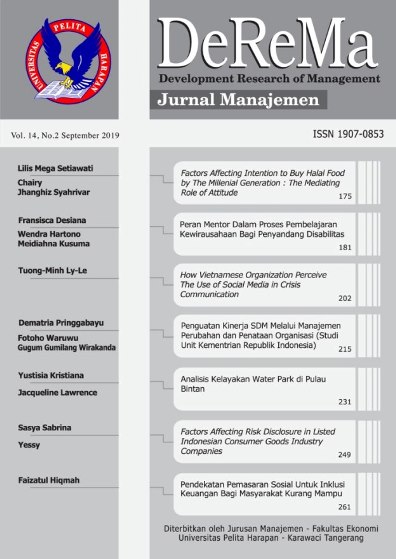Pendekatan Pemasaran Sosial Untuk Peningkatan Inklusi Keuangan Bagi Masyarakat Kurang Mampu [A Social Marketing Approach to Increase Financial Inclusion for Underprivileged Communities]
DOI:
https://doi.org/10.19166/derema.v14i2.1418Kata Kunci:
financial inclusion, social marketing, bantuan pangan non-tunai, marketing communicationAbstrak
This research attempt to explore financial inclusion program executed through cashless food aid conducted by Ministry of Social Services[m1] , Indonesia’s Bank and Indonesia’s Financial Services Authority. Cashless food aid enable the underprivileged society that formerly have no access at all to financial or banking services, to finally have bank account, ATM card, and even doing their cashless transaction through e-stall. However, practically this program is facing some obstacles, especially on technology adoption by underprivileged society. Through social marketing approach, it is expected that financial inclusion program in Indonesia will have more precise strategy. Social marketing itself, has been demonstrated to be an effective tools of behavior change, especially on health initiatives and poverty reduction (Truong & Hall, 2015) Using qualitative method, this research is doing in depth interview with 15 beneficiaries’ family in Mojokerto as the receiver cashless food aid, to have insight on how they perceive financial inclusion program, what are their obstacles, and what are their expectations from this program. By analyze through the social marketing’s approach, the result of this research showed that facilitating condition, interpersonnal communication, and intense socialization, are played an important role on succeding the financial inclusion program as the key to the barriers that is faced by the beneficiaries family when performing behavioral change on financial activity.
Bahasa Indonesia Abstrak: Penelitian ini berusaha mengeksplorasi program inklusi keuangan yang dilakukan lewat penyaluran bantuan pangan non-tunai oleh Kementrian Sosial, Bank Indonesia, dan OJK. Penyaluran bantuan pangan non-tunai memungkinkan masyarakat kurang mampu yang sebelumnya tidak memiliki akses sama sekali terhadap layanan keuangan, untuk akhirnya bisa memiliki rekening bank mereka sendiri, kartu ATM , dan juga melakukan transaksi non-tunai melalui warung tertentu yang telah ditunjuk. Namun demikian, aplikasi dari program ini juga mengalami beberapa hambatan, terutama dalam hal adopsi teknologi yang harus ditunjukkan oleh keluarga penerima bantuan. Melalui pendekatan pemasaran sosial, diharapkan program inklusi keuangan di Indonesia akan bisa mendapatkan strategi yang lebih tepat. Pemasaran sosial sendiri telah lama menunjukkan keefektivitasannya dalam upaya peubahan perilaku, terutama untuk inisiasi kesehatan dan pengentasan kemiskinan (Truong & Hall, 2015). Dengan menggunakan pendekatan kualitatif, penelitian ini melakukan wawancara mendalam dengan 15 keluarga penerima manfaat di Mojokerto, dengan tujuan mendapatkan pandangan yang lebih mendalam atas program ini, hambatan, serta harapan mereka. Dengan melakukan proses analisa menggunakan pendekatan pemasaran sosial, hasil dari penelitian ini menunjukkan bahwa kondisi yang memfasilitasi, komunikasi interpersonal, serta sosialisasi yang intense memainkan peranan penting dalam mensukseskan program inklusi keuangan, sebagaimana hal tersebut merupakan cara mengatasi hambatan yang dihadapi keluarga penerima manfaat saat melakukan perubaha perilaku dalam hal aktivitas finansial.
Referensi
Aaker, D., Kumar, V., & Day, G. (2007). Marketing research (9th ed.). Hoboken, NJ: John Wiley & Sons, inc.
Andreasen, A. (1994). Social marketing: Its definition and domain. Journal of Public Policy & Marketing, 13(1), 108-114. https://doi.org/10.1177%2F074391569401300109
Andreasen, A. (1995). Marketing social change: Changing behavior to promote health, social development, and the environment. Washington DC: Jossey-Bass Inc.
Andreasen, A. (2002). Social marketing in the social change marketplace. Journal of Public Policy & Marketing, 21(1), 3-13. https://doi.org/10.1509%2Fjppm.21.1.3.17602
Andreasen, A. (2006). Social marketing in the 21st century. London: Sage
Andreasen, A. R. (2012). Rethinking the relationship between social/non-profit marketing and commercial marketing. Journal of Public Policy and Marketing, 31(1), 36-41. https://doi.org/10.1509%2Fjppm.09.035
Bank of Indonesia. (2014). Booklet Keuangan Inklusif Bank Indonesia. Retrieved from Bank Indonesia https://www.bi.go.id/id/Default.aspx
Bank of Indonesia. (2018). Bank Indonesia. Retrieved from Bank Indonesia https://www.bi.go.id/id/perbankan/keuanganinklusif/edukasi/Contents/Buku%20Saku%20Keuangan%20Inklusif.pdf
Beck, T., Demirgüç-Kunt, A., & Levine, R. (2007). Finance, inequality and the poor. Journal of Economic Growth, 12(1) 27-49. https://doi.org/10.1007%2Fs10887-007-9010-6
Bunce, A., & Johnson, L. (2006). How many interviews are enough? An experiment with data saturation and variability. Field methods, 18(1), 59-82. https://doi.org/10.1177/1525822X05279903
Bungin, B. (2011). Penelitian Kualitatif. Jakarta: Kencana Predana Media.
Chi, T., & Yamada, R. (2002). Factors affecting farmers’ adoption of technologies in farming system: A case study in Omon district, Can Tho province, Mekong Delta. Omonrice, 94-100.
Chung, W., & Paynter, J. (2002). An evaluation of Internet banking in New Zealand. Proceedings of the 35th Annual Hawaii International Conference on 2002 Jan 7 (2410-2419). Hawaii: IEEE.
Conroy, D. M., & Lee, C. K. C. (2006). Imposed change and social sustainability. International Journal of Environmental. Cultural, Economic and Social Sustainability, 2(4), 64-70.https://doi.org/10.18848/1832-2077/cgp/v02i04/54246
Covello, V. (2003). Best practices in public health risk communication and crisis communication. Jornal of Health Communication, 8(3), 5-8. https://doi.org/10.1080/10810730305705
Creswell, J. (1998). Qualitative inquiry and research design: Choosing among five tradition. London: Sage.
Dann, S. (2010). Redefining social marketing with contemporary commercial marketing definitions. Journal of Business Research, 63(2), 147-153. https://doi.org/10.1016/j.jbusres.2009.02.013
Das, R., & Pal, S. (2011). Exploring the factors affecting the adoption of mobile financial services among the rural under-banked. Proceeding of European Conference on Information Systems (ECIS) (p. 246). ECIS, 246-259. Istanbul: Asscociation for Information Systems.
Davis, F., Bagozzi, R., & Warshaw, P. (1989). User acceptance of computer technology: a comparison of two theoretical models. Management science, 35(8), 982-1003. https://doi.org/10.1287%2Fmnsc.35.8.982
Demirguc-Kunt, A., & Klapper, L. (2012). Measuring financial inclusion: The global findex database. Washington DC: World Bank. https://doi.org/10.1596/1813-9450-6025
Dibb, S. (2014). Up, up and away: Social marketing breaks free. Journal of Marketing Management, 30(11-12), 1159-1185. https://doi.org/10.1080%2F0267257x.2014.943264
French, J., & Blair-Stevens, C. (2006). Social marketing national benchmark criteria. UK: UK National Social Marketing Centre.
Fuglie, K. O., & Kascak, C. A. (2001). Adoption and diffusion of natural-resource-conserving agricultural technology. Review of Agricultural Economics, 23(2), 386-403. https://doi.org/10.1111%2F1467-9353.00068
Grier, S., & Bryant, C. A. (2005). Social marketing in public health. Annual Review of Public Health, 26(1), 319-339. https://doi.org/10.1146%2Fannurev.publhealth.26.021304.144610
Hall, C. (2014). Tourism and social marketing. New York, NY: Routledge. https://doi.org/10.4324/9780203854259
Hastings, G. (2007). Social marketing: Why should the devil have all the best tunes? Oxford: Elsevier.
Hastings, G., Angus, K., & Bryant, C. (2011). The SAGE Handbook of Social Marketing. London: Sage.
Hastings, G., & Domegan, C. (2013). Social marketing. New York, NY: Routledge.
Hastuti, T. (2004). Evaluasi terhadap pelaksanaan komunikasi pemasaran sosialnon-government organization (NGO) untuk isu-isu anti kekerasan terhadap perempuan : studi kasus kampanye anti kekerasan terhadap perempuan Cut Nyak Dien Yogyakarta dan Solidaritas perempuan untuk ha. Jurnal Ilmu Komunikasi, 3(2). https://doi.org/10.24002%2Fjik.v3i2.236
Hiqmah, F. (2017). Social marketing: A proposed framework to reduce poverty in Indonesia. Proceeding of the Sixth Annual South East Asian International Seminar (ASAIS) (p. 150). Jakarta: P3M Politeknik Negeri Jakarta.
Jain, A., & Hundal, B. (2007). Factors influencing mobile services adoption in rural India. Asia-Pacific Journal of Rural Development, 17(1), 17-28. https://doi.org/10.1177%2F1018529120070102
Jardine, C. G. (2003). Development of publication participation and communication protocol for establishing fish consumption advisories. Risk Analysis, 23(3), 461-471. https://doi.org/10.1111/1539-6924.00327
Jayaputra, A., Muhtar, Syawie, M., Pudjianto, B., Amalia, A., & Belanawane, M. (2017). Kepuasan keluarga penerima manfaat terhadap bantuan tunai dan nontunai. Jakarta: Pusat penelitian dan pengembangan kesejahteraan sosial kementrian sosial RI.
Kharismawati, I. S., & Rosdiana, W. (2018). Implementasi bantuan pangan non-tunai (BPNT) melalui E-Warung di Kelurahan Sidosermo Kecamatan Wonocolo Kota Surabaya. Publika.
Kotler, P., & Zaltman, G. (1971). Social marketing: An approach to planned social change. The Journal of Marketing, 35(3), 3-12. https://doi.org/10.1177%2F002224297103500302
Kotler, P., & Lee, N. (2009). Up and out of poverty: The social marketing solution. Upper Saddle River, NJ: Pearson.
Lee, N. R., & Kotler, P. (2011). Influencing behaviors for good. Thousand Oaks, CA: Sage
Lee, N. R., & Kotler, P. (2012). Good works! Marketing and corporate initiatives that build a better world and the bottom line. Hoboken, NJ: Wiley and Sons, Inc. https://doi.org/10.1002/9781119205210Lee, N. R., & Miller, M. (2012). Influencing positive financial behaviors: the social marketing solution. Journal of Social Marketing, 2(1), 70-86. https://doi.org/10.1108%2F20426761211203265
Lefebvre, R. C. (2011). An integrative model for social marketing. Journal of Social Marketing, 1(1), 54-72. https://doi.org/10.1108%2F20426761111104437
Lundgren, R. (1994). Risk Communication: A handbook for communication of environmental safety and health risks. Columbus, OH: Battelle Press.
McDermott, M., Chess, C., Perez-Lugo, M., Pflugh, K., Bochenek, E., & Burger, J. (2003). Communicating a complex message to the population most at risk: An outreach strategy for fish consumption advisories. Applied Environmental Education and Communication, 39-48. https://doi.org/10.1080/15330150301346
McKenzie-Mohr, D., & Schultz, P. W. (2014). Choosing effective behavior change tools. Social Marketing Quarterly, 20(1), 35-46. https://doi.org/10.1177%2F1524500413519257
Merdeka.com. (2018). Merdeka.com. Retrieved from merdeka.com https://m.merdeka.com/uang/bi-ungkap-penyebab-inklusi-keuangan-indonesia-tumbuh-lambat.html
Meyrick, J. D. (2010). Tobacco smoking's changing trajectory in Australia. Journal of Business Research, 63(2), 161-165. https://doi.org/10.1016/j.jbusres.2009.02.010
Miles, M., Huberman, M., & Huberman, M. (1994). Qualitative data analysis: An expanded sourcebook. London: Sage.
Morgan, S. E., Cole, H. P., & Struttman, L. P. (2002). Stories or statistics? Farmers’ attitudes toward messages in an agricultural safety campaign. Journal of Agricultural Safety and Health. https://doi.org/10.13031%2F2013.8427
Mukherjee, J. (2015). Mobile Money Adoption in India: Evidence from early adopters of technology. Vilakshan: The XIMB Journal of Management, 12(2), 95-118.
Nanda, A. K. (2013). Social marketing : A literature review. International Journal of Science and Research, 4(9), 697-702.
Novelli, W. (1984). Developing marketing programs. Marketing Health Behavior, 59-89. https://doi.org/10.1007/978-1-4899-0366-2_4
Polson, R. A., & Spencer, D. S. C. (1991). The technology adoption process in subsistence agriculture: The case of cassava in Southwestern Nigeria. Agricultural Systems, 36(1), 65-78. https://doi.org/10.1016%2F0308-521x%2891%2990108-m
Pudjiastuti, W. (2002). Strategi masalah kesehatan dan lingkungan hidup di pemukiman kumuh lewat program pemasaran social. Makara Human Behavior Studies in Asia, 6(2), 76. https://doi.org/10.7454%2Fmssh.v6i2.43
Rangun, V., & Karim, S. (1991). Teaching note: Focusing the concept of social marketing. Cambridge, MA: Harvard Business School.
Rekha, P., & Jain. (2017). Impact of demographic factors: Technology adoption in agriculture. SCMS Journal of Indian Management, 93-102.
Rothschild, M. (1999). Carrots, sticks, and promises: A conceptual framework for the management of public health and social issue behaviors. The Journal of Marketing, 63(4), 24-37. https://doi.org/10.1177%2F002224299906300404
Russell-Bennett, R., Previte, J., & Zainuddin, N. (2009). Conceptualising value creation for social change management. Australasian Marketing Journal (AMJ), 17(4), 211-218. https://doi.org/10.1016%2Fj.ausmj.2009.06.002
Samuel, Hatane, & Foedjiwati. (2006). Penilaian kelompok kritis terhadap sosialisasi Inpres no. 10 Tahun 2005; suatu tinjauan dari sudut pemasaran sosial. Jurnal Manajemen Pemasaran, 1(1), 1-12.
Sargeant, J. (2012). Qualitative research part II: Participants, analysis, and quality assurance. Journal of Graduate Medical Education, 4(1), 1-3. https://doi.org/10.4300/JGME-D-11-00307.1
Setiawan, S. (2015). Financial depth and financial access in Indonesia. Journal of Indonesian Economy and Business, 29(3), 139-158. https://doi.org/10.9744%2Fpemasaran.10.1.35-42
Susanto, T. A. (1998). Pemasaran sosial dalam program keluarga berencana. Jurnal Cakrawala Pendidikan, 3(1), 27-31.
Tapp, A., & Spotswood, F. (2013). From the 4Ps to COM-SM: reconfiguring the social marketing mix. Journal of Social Marketing, 3(3), 206-222. https://doi.org/10.1108%2Fjsocm-01-2013-0011
Terblanche-Smit, M., & Terblanche, N. (2010). Race and attitude formation in HIV/Aids fear advertising. Journal of Business Research, 63(2), 121-125. https://doi.org/10.1016%2Fj.jbusres.2009.02.008
Tobbin, P. (2011). Modeling adoption of mobile money transfer: A consumer behavior analysis. 2nd International Conference on Mobile Communication Technology for Development (pp. 1-10). Kampala: Aalborg Universiteit.
Truong, V. (2014). Social marketing: A systematic review of research 1998-2012. Social Marketing Quarterly, 20(1), 15-34. https://doi.org/10.1177/1524500413517666
Truong, V., & Hall, C. (2015). Exploring the poverty reduction potential of social marketing in tourism development. Austrian Journal of South-East Asian Studies, 8(2), 125-142.
Truong, V., Dang, N., Hall, C., & Dong, X. (2015). The internationalisation of social marketing research. Journal of Social Marketing, 5(4), 357-376.https://doi.org/10.1108%2Fjsocm-04-2014-0025
Truong, V., Hall, C., & Garry, T. (2014). Tourism and poverty alleviation: Perceptions and experiences of poor people in Sapa, Vietnam. Journal of Sustainable Tourism, 22(7), 1071-1089. https://doi.org/10.1080/09669582.2013.871019
Venkatesh, V., Morris, M., Davis, G., & Davis, F. (2003). User acceptance of information technology: Toward a unified view. MIS quarterly, 27(3), 425. https://doi.org/10.2307%2F30036540
Wettstein, D., & Suggs, S. L. (2016). Is it social marketing? The benchmark meet the social marketing indicator. Journal of Social Marketing, 6(1), 2-17. https://doi.org/10.1108%2Fjsocm-05-2014-0034
WHO. (2002). World Health Organization (WHO): Safer food for better health. Retrieved from www.who.int/entity/foodsafety/publications/ge neral/en/strategy.en.pdf. 2002
Yulianita, N. (2008). Corporate Social Responsibility”(CSR) sebagai Aktivitas “Social Marketing Public Relations. MediaTor (Jurnal Komunikasi), 9(1), 123-134.https://doi.org/10.29313%2Fmediator.v9i1.1145
Zainuddin, N., Previte, J., & Russell-Bennett, R. (2011). A social marketing approach to value creation in a well-women's health service. Journal of Marketing Management, 27(3-4), 361-385. https://doi.org/10.1080/0267257x.2011.547081
Zhang, J., Zheng, X., Zhang, X., & Fu, Z. (2010). Farmers information acceptance behaviour in China. African Journal of Agricultural Research, 5(3), 217-221.
Unduhan
Diterbitkan
Terbitan
Bagian
Lisensi
Authors who publish with this journal agree to the following terms:
1) Authors retain copyright and grant the journal right of first publication with the work simultaneously licensed under a Creative Commons Attribution License (CC-BY-SA 4.0) that allows others to share the work with an acknowledgement of the work's authorship and initial publication in this journal.
2) Authors are able to enter into separate, additional contractual arrangements for the non-exclusive distribution of the journal's published version of the work (e.g., post it to an institutional repository or publish it in a book), with an acknowledgement of its initial publication in this journal.
3) Authors are permitted and encouraged to post their work online (e.g., in institutional repositories or on their website). The final published PDF should be used and bibliographic details that credit the publication in this journal should be included.





